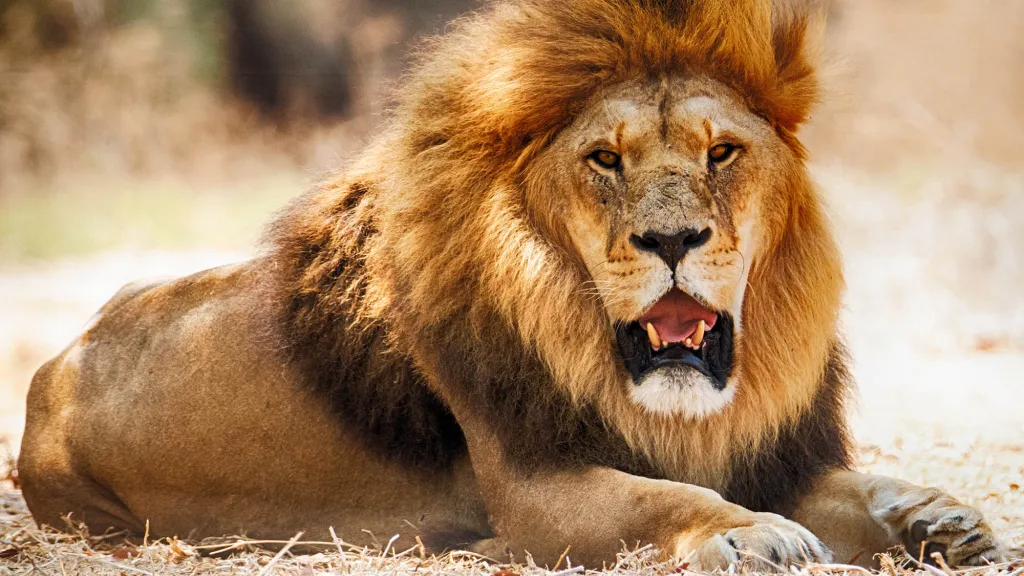ARTS & CULTURE
10 Facts About Lions That Will Blow Your Mind
Published
1 year agoon
By
wpadminee
Lions: they roar, they’re fierce, and they’re the undisputed kings of the jungle, right? While all that’s true, there’s a whole lot more to these majestic creatures than meets the eye.
Beyond their undeniable strength and bravery lies a world of fascinating facts and surprising behaviours that might just blow your mind. We will see some of these facts below. So, buckle up and get ready to discover 10 incredible things about lions you never knew.
1. Lions don’t live in jungles
While you might often hear lions referred to as the “King of the Jungle,” the truth is, they don’t actually live in jungles! This nickname likely arose from a couple of reasons. One possibility is that it’s simply a result of a translation error. In some languages, the word for “lion” is similar to the word for “jungle cat,” which could have been misinterpreted.
Another possibility is that it stems from a more general lack of understanding of where lions actually live. Historically, people in Europe and North America may not have been familiar with the specific types of habitats found in Africa, where most lions reside. So, they might have mistakenly applied the term “jungle” to any wild, untamed area, and lions, being the apex predators in their environment, naturally became the “kings” of these imagined jungles.
In reality, lions primarily make their homes in grasslands, savannas, and open woodlands. These regions provide them with the perfect combination of hunting grounds and cover to thrive.
2. Their roars can be heard 5 miles away
Lions don’t just roar to sound tough; they’re actually having a loud conversation. Their roars can reach a whopping 114 decibels, which is about as loud as a motorcycle engine. That’s enough to be heard over 5 miles away, almost like sending a sound message across the savanna.
These mighty roars are how lions talk to each other, letting everyone know where their territory starts and reminding other lion groups to stay away. It’s like a long-distance phone call, but way cooler.
3. Lions are lazy
While many might picture ferocious kings of the jungle constantly on the prowl, lions actually surprise us with their laid-back lifestyle. These big cats are champs at chilling, spending a whopping 20 hours a day snoozing or relaxing.
Why the need for all that rest? They’re strategic planners. By conserving their energy during the day, they’re perfectly fueled for hunting expeditions during the cooler nighttime hours.
Think of them as nocturnal ninjas, taking advantage of the darkness to catch their prey with renewed energy and stealth.
4. Lions are incredibly fast
Don’t let their chill vibes fool you. Lions might be the ultimate nap champions; they don’t mess around when it comes to hunting. When duty calls, these big cats can transform into speedy predators.
In short bursts, they can zoom across the savanna at 50 miles per hour (80 kilometres per hour)! That’s almost as fast as a car driving in the city! This impressive burst of speed helps them catch their prey by surprise, ensuring a successful meal after all that lounging around.
5. Their mane is not just for show
Lions aren’t just about roaring and lounging around. Their manes aren’t just stylish accessories; they actually tell a story. A male lion’s mane is like a built-in resume, revealing clues about his health, age, and even how manly he is.
Like a badge of honour, a darker, fuller mane tells everyone that this lion is strong and healthy. Not only does that impress the ladies (lionesses), but it also sends a clear message to other male lions: “Don’t mess with me; I’m the king of the jungle.”
Crazy, right? Whenever you see a lion with a magnificent mane, remember, that it’s not just fur—it’s a walking advertisement for his awesomeness.
6. Female lions do most of the hunting
The mighty lion might roar the loudest, but it’s actually the lionesses who are the real action heroes of the pride. These fierce females are the hunting squad, working together like a well-oiled machine to take down even the biggest prey.
Forget the image of lions lazing around all day. These lionesses are strategic and organised, coordinating attacks to surround and capture animals like zebras, wildebeests, and even towering giraffes.
Teamwork makes the dream work, and these lionesses prove it every time they bring home a meal for the whole pride.
7. Lions are social cats
Lions may be big cats, but unlike their loner cousins, like tigers or leopards, they love company. They live in groups called prides, which can be like big, bustling families with up to 30 members.
But here’s the twist: the queen bees in this pride are the lionesses. These strong females lead the whole crew, taking charge of hunting food and raising all the adorable cubs together. Forget the image of a lone lion ruling the savanna – lions are all about teamwork and girl power.
8. Unique footprint
Did you know every lion has its own special freckle code? Just like humans have unique fingerprints, each lion has a distinct pattern of spots on their whiskers. These whisker spots are like personal ID cards for lions—so different that researchers can use them to tell individual lions apart in the wild.
It’s like a secret language hidden right under their noses, helping scientists track and learn all about these fascinating creatures. Pretty cool, right?
9. Lion cubs are born with spots
Lion cubs are adorable little creatures with fluffy fur and big, curious eyes. But did you know that they also have a built-in disguise? When they are born, lion cubs are covered in dark spots that help them blend in with their surroundings. This camouflage is essential for their survival, as it helps them hide from predators while they are still young and vulnerable.
The spots on a lion cub’s fur are similar to the spots on a leopard’s fur. They help to break up the cub’s outline, making it more difficult for predators to see them. This is especially important in the tall grass and savannas where lions live, as these environments provide plenty of hiding places for predators.
The spots on a lion cub’s fur will gradually fade as they grow older. By the time they are adults, the spots will usually be gone completely. However, some lions will retain faint spots into adulthood. These spots are a reminder of the cub’s playful past and their time spent hiding from danger.
10. Lions are threatened species
The future of these majestic creatures is uncertain. Lions are sadly listed as “vulnerable” on the Red List, which means they’re at risk of disappearing forever. Over the past 20 years, their numbers have dropped by almost half—that’s like 4 out of every 10 lions gone. This decline is mainly due to three big threats:
- Losing their homes: Lions need wide-open spaces to roam and hunt, but their natural habitat is shrinking as more land is used for farming and other human activities. It’s like their jungle gyms are disappearing.
- Clashing with humans: Sometimes, lions and humans come into conflict, especially when they wander near villages or livestock. This can lead to both lions and people getting hurt, which is never a good thing.
- Poaching: Sadly, some people hunt lions illegally for their body parts, even though it’s against the law. This is like stealing from the animal kingdom.
These threats are serious, but people are working hard to protect lions. By learning more about these amazing animals and supporting conservation efforts, we can all help give them a roar-some future.
Check out more facts here.
You may like
-


7 Facts About Samuel Nwajagu, Mister International 2024
-


Do Bras Really Keep Breasts From Sagging? Check This Out!
-


5 Things You Should Always Keep Private
-


Why Do Women Live Longer Than Men? See Reasons Behind The Longevity Gap
-


How To Beat The Monday Blues: Simple Strategies For A Smoother Start
-


Rainy season: How To Prevent Home Flooding
ARTS & CULTURE
Ijele Masquerade: The “King Of Masquerades” In Igbo Land
Published
4 months agoon
December 21, 2024By
wpadminee
The Ijele Masquerade, often referred to as the “King of Masquerades,” holds a revered position in Igbo culture. It is not only the largest masquerade in Africa but also a symbol of unity, spirituality, and cultural identity among the Igbo people.
Its towering presence, vibrant artistry, and profound symbolism make it a centrepiece of Igbo traditions.
The Ijele Masquerade originated in southeastern Nigeria, particularly in Anambra and Enugu states. Oral traditions trace their roots to the Akwunechenyi dance group in Umueri.
It began as a celebratory and protective figure, initially created to intimidate invaders and celebrate royalty. Over time, it evolved into a cultural icon representing greatness and the Igbo people’s connection to their ancestors.
Standing between 12 and 15 feet tall, the Ijele Masquerade is a marvel of craftsmanship. It is constructed from bamboo, colourful fabrics, and intricate carvings.
Its structure is divided into two segments: the upper (Mkpu Ijele) and the lower part (Akpakwuru Ijele), separated by a symbolic python figure, Eke-Ogba.
This design signifies the balance between the spiritual and earthly realms. The preparation of the masquerade requires extensive collaboration, with over 100 men working for six months to complete its elaborate design.
Cultural and Spiritual Significance of Ijele Masquerade
The Ijele Masquerade embodies the collective spirit of the Igbo community. It is a representation of the ancestors’ guidance, protection, and blessings.
Traditionally performed during festivals, burials, and special ceremonies, the Ijele is believed to have spiritual powers, such as warding off evil spirits, promoting fertility, and bringing healing.
Its performance is both a spectacle of entertainment and a deeply spiritual ritual that connects the living to their heritage.
The Ijele Masquerade is a highlight of Igbo cultural festivals, often serving as the grand finale. Accompanied by music, drumming, and traditional dances, its performance captivates audiences with its grandeur and artistry.
These events also serve as a platform for preserving and promoting Igbo heritage, attracting tourists, and generating economic benefits for the community.
Challenges Facing Ijele Masquerade
Despite its cultural significance, the Ijele Masquerade faces challenges in the modern era. Urbanisation, globalisation, and declining interest among younger generations threaten its preservation.
The elaborate nature of its preparation also requires significant funding and resources, which are often scarce. Additionally, cultural appropriation by outsiders risks diluting its authenticity and significance.
Efforts to preserve the Ijele Masquerade have gained international recognition. In 2009, UNESCO listed it as an intangible cultural heritage in need of safeguarding.
This recognition highlights the importance of supporting local communities to maintain their traditions. Advocacy for funding, education, and tourism initiatives is vital to ensuring the continuity of this cultural treasure.
A Symbol of Igbo Identity
The Ijele Masquerade remains a powerful symbol of Igbo identity and resilience. It is a testament to the creativity, spirituality, and unity of the Igbo people.
As it continues to inspire pride and admiration, the Ijele Masquerade underscores the importance of preserving cultural heritage in a rapidly changing world.
By supporting initiatives that promote Ijele, individuals and organisations can help sustain this remarkable tradition for future generations.
Its legacy is not only a source of pride for the Igbo people but also a significant contribution to the global appreciation of cultural diversity.
For further details about the Ijele Masquerade, see sources like UNESCO’s Intangible Cultural Heritage listing and articles exploring its cultural significance.
Read more on culture here.
ARTS & CULTURE
Does Anklet Really Signify Promiscuity?
Published
4 months agoon
December 7, 2024By
wpadminee
What is an anklet?
An anklet is a versatile piece of jewellery that women typically wear around their ankles. Crafted from materials like chains, beads, or a mix of both, anklet meanings vary across cultures and styles.
Many fashionable women choose anklets to make a bold style statement, embracing their elegance and charm.
In Nigeria, people often call this accessory a “leg chain” or “ankle chain,” reflecting its cultural relevance. In pop culture, it’s popularly known as an “ankle bracelet.”
Anklets here focus more on fashion than symbolism, though interpretations can differ. With various styles and intricate designs available, anklets offer countless aesthetic options, allowing women to showcase their personal flair.
Ultimately, anklet meanings can be deeply personal, influenced by tradition, culture, or simply individual taste.
Cultural and Historical Significance
Throughout history, anklets have held different meanings across various cultures. While some view them as mere adornments, others have associated them with deeper, sometimes controversial, connotations.
In some societies, ancient and modern, anklets symbolise promiscuity.
Early Usage in Ancient Civilisations
Egypt is often credited as the birthplace of anklets, but India played a significant role in their widespread acceptance. In India, anklets were part of traditional attire, known as pattilu, payal, or nupu.
These terms also include Paujinupur and padapadma. Early Indian literature, such as the first-century epic Silappatikaram, mentions anklets, highlighting their cultural importance.
Rajasthani women were known for their elaborate anklet designs, reflecting regional traditions.
Among the Odisha people, gold anklets were once reserved for warriors, while brides included them as part of their wedding regalia.
Married women often wore anklets to signify their marital status, and dancers used those with dangling bells to enhance their performances.
Similarly, in ancient Egypt, anklets indicated social status. Wealthy women wore gold anklets, while silver or leather versions were common among slaves and the poor.
These accessories, known as menefret or kholkai, reflected one’s place in the social hierarchy. Interestingly, some accounts suggest that anklets were linked to temple worshippers and even prostitutes, though these claims remain largely unverified.
Modern Evolution and Symbolism
Over time, the meaning of anklets has evolved significantly. In the 1970s, during America’s “sexual revolution,” anklets became symbols of female empowerment and liberation.
This era emphasised women’s freedom to express themselves, including their sexuality. Consequently, anklets began to carry connotations of promiscuity, especially within the “hotwife” culture.
The “Hotwife” Phenomenon
A “hotwife” refers to a married woman who engages in consensual extramarital relationships with her husband’s approval. Various anklet symbols reflect this dynamic:
- Two male symbols and one female symbol: Indicate openness to relationships with men of any race.
- Queen of spades: Represents a preference for Black men.
- Heart symbol: Suggests a happy marriage that includes mutually beneficial intimate relationships outside the primary partnership.
- The key to happiness: Denotes a marriage where the husband’s extramarital activities are contingent on his wife’s consent.
Anklets in Contemporary Nigerian Fashion
Today, many Nigerian women wear anklets purely for their aesthetic appeal, often unaware of the historical or cultural associations. For them, anklets are fashion accessories, not symbols of promiscuity or class distinction.
Despite lingering societal judgments, especially within conservative African contexts, it’s essential to recognize that fashion choices are personal.
Women should not face harsh criticism for wearing anklets, as these judgments stem from outdated or culturally irrelevant perspectives.
In conclusion…
Anklets are versatile fashion pieces that have transcended their historical roots. While some cultural connotations persist, modern women wear anklets to express their style and individuality.
It is crucial to separate fashion from judgement and allow women the freedom to make their own choices about their bodies and accessories.
Let’s appreciate anklets for what they are today: beautiful, empowering symbols of self-expression.
Read more articles here.
AFRICAN
The Only 4 African Countries That Have Won Miss Universe Title
Published
4 months agoon
December 7, 2024By
wpadminee
While many African countries have sent representatives to the pageant, only a few have managed to clinch the coveted Miss Universe crown.
The Miss Universe pageant is one of the most prestigious beauty pageants worldwide. It has been a stage for countless beautiful women to showcase their elegance, intelligence, and talent.
1. South Africa
South Africa is the African country with the most Miss Universe wins. This stunning nation has produced four Miss Universe winners:
- Margaret Gardiner (1978)
- Demi-Leigh Nel-Peters (2017)
- Zozibini Tunzi (2019)
- Andrea Meza (2020)
These South African beauties have not only captivated the world with their beauty but have also used their platforms to advocate for important social causes.
2. Namibia
Namibia, a small country in Southern Africa, has also made its mark on the Miss Universe stage.
- Michelle McLean won the Miss Universe title in 1992.
This stunning Namibian beauty brought pride to her nation and continues to be an inspiration to many.
3. Angola
Angola, a country rich in culture and natural beauty, has also produced a Miss Universe winner.
- Leila Lopes was crowned Miss Universe in 2011.
Her win marked a significant moment for Angola and showcased the beauty and talent of African women.
4. Botswana
Botswana, a landlocked country in Southern Africa, may be small, but it has produced one of the most iconic Miss Universe winners.
- Ntsepa Motsepe won the Miss Universe title in 1999.
Her win was a surprise to many, but it solidified Botswana’s place in the pageant world.
These four African countries – South Africa, Namibia, Angola, and Botswana – have proven that African beauty is truly global.
They have inspired countless young women across the continent and beyond to dream big and pursue their passions.
As the Miss Universe pageant continues to evolve, we can only hope to see more African countries adding their names to this prestigious list.
Check here for more articles.
Latest


Samsung Galaxy S25 Series Sets The Standard Of AI Phones As A True AI Companion
Samsung Galaxy S25 series sets the standard of AI phones as a true AI companion …Pioneering the multimodal era with...


5 Things To Expect In Afrobeats In 2025
Afrobeats is poised to reach unprecedented heights in 2025 as Nigerian music continues its remarkable global ascent. The genre’s explosive...


Here Are The 7 Most Ancient Countries On Earth
The oldest countries in the world stand as remarkable testaments to human civilisation, each containing landscapes and monuments that narrate...


Why Self-Reflection Is More Important Than Resolutions
Millions of people embark on a yearly ritual: they sit down with a notebook and pen, eager to craft a...


Nollywood Director, Kemi Adetiba Teases King Of Boys 3
Nollywood director Kemi Adetiba has revealed that another instalment of King of Boys will be released on December 25, 2025....


John McEnroe Says He Can Be The Commissioner Tennis Needs Amid Doping Crisis
Recent doping controversies involving top players have not damaged tennis’s reputation, but John McEnroe believes that appointing a single commissioner...


“Everybody Loves Jenifa” Becomes Nollywood’s Highest-Grossing Film Of All Time
Nollywood filmmaker Funke Akindele has achieved a historic milestone with her latest film, “Everybody Loves Jenifa.” The film has officially...


FG To Premiere TV Series, “Hidden Riches” On Mining Sector On January 25
Nigeria’s Federal Government will launch an ambitious television drama series focused on the nation’s mining sector, premiering “Hidden Riches” on...


Qing Madi Delivers A Soulful Performance Of “Favourite Pyscho”
Rising Afro-RnB sensation Qing Madi launches into 2025 with a mesmerising performance on the prestigious COLOURS platform, showcasing her latest...


Taiwo Awoniyi’s First Goal Of The Season Seals Nottingham Forest’s Win Over Wolves
Taiwo Awoniyi made a triumphant return to Premier League action. He scored in stoppage time to help Nottingham Forest crush...
-Ad-




